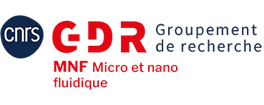POSTDOC Trafic passif et actif de gouttes sur réseaux
Posté le 25 février 2013 dans Offre d'emploi par Bertrand Genevois.
We look for a candidates for a postdoctoral position in Paris, at ESPCI, within our team (EC2M – Collective Effects in Soft Matter http://www.ec2m.espci.fr), to study experimentally
To be eligible, this application should be the first postdoctoral position of the candidate.
To obtain the position, the candidate will have to apply for the second round of a grant for which we successfully went through the first round. The rate of success for the second round is 25%. In case of success, the position is to be taken before june 2014 (and reasonably after summer 2013).
The file must be sent before the 7th of March at midnight!
Necessary documents include a CV. A letter of recommendation is also welcome.
Tout dossier reçu incomplet sera considéré comme inéligible et seuls les projets soumis avant la date limite via le site de soumission en ligne seront étudiés.
Titre du projet de recherche : Trafic passif et actif de gouttes sur réseaux
Sujet développé (à présenter en 1 page maximum en français ou en anglais, en précisant notamment le contexte, les objectifs, les méthodes et les résultats attendus)
Hundreds of natural and industrial processes ultimately rely on the transport of mobile agents in obstacle,or channel,networks. Prominent examples concern: particle filtration, blood flows in micro-vessels, droplet-based-microfluidics. In all these examples, passive particles are advected by external force fields and traffic through heterogeneous environment. A second important class of traffic phenomena deals with self-propelled agents. The most obvious realizations are the traffic flows of vehicle, and pedestrian in the urban networks but numerous similar processes take place in living systems at much smaller scales: bacteria in polluted soils and in host, or contaminated, organs; or the so-called cytoplasmic streaming, which ensures the transport of organelles through the eukaryotic cells along the cytoskeletal network.
The diversity of the systems, where traffic flows is involved calls for investigating their universal properties, thereby making the problem highly appealing from a fundamental perspective. In return, a generic comprehension of the mechanisms at play would drive the emergence of potential applications in many different fields of technological importance.
We intend to develop a generic understanding of the traffic dynamics in obstacle and channel networks. More precisely we shall concentrate on one well-identified axis ofresearch: Clogging. When the particle size compares to the typical width of the channels, or to the distance between obstacles, the traffic flows in fluidic network becomes a highly challenging problem. The particles then behave as “mobile clogs”, which locally modify the network conductivity. The local particle current then depends a » priori on the position of all the other particles in the network, making the problem nonlinear and nonlocal. We aim at providing the first quantitative experimental investigation of this problem in extended networks for both driven passive and active droplets.
To achieve these goals, we will take advantage of the expertise we have recently developed on the creation, the manipulation and the observation of a new kind of self-propelled agents, namely Swimming droplets. The postdoc will benefit from this expertise and, depending on the profile of the best candidate we will identify, he will contribute to the experimental work on one or both experiments and/or work on the modelisation of the above situations.
At the end of the day, we expect (i) to develop a unique analogic toolbox to investigate the collective dynamics of active and passive agents in heterogeneous media and (ii) a precise description of the traffic statistics both in ordered and disordered 2D networks.
